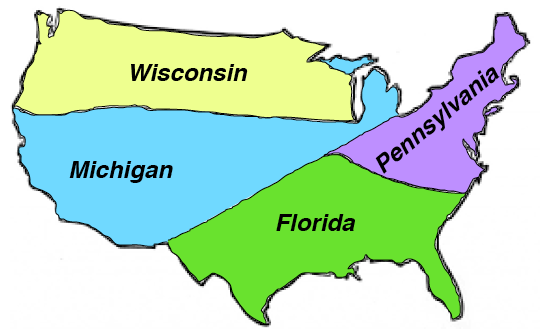In an August 21, 2019 article entitled "The 2020 Electoral Map Could Be the Smallest in Years," Dan Balz of the Washington Post wrote:
"The 2020 general election could be contested on the narrowest electoral terrain in recent memory."
"Just four states are likely to determine the outcome in 2020. Each flipped to the Republicans in 2016, but President Trump won each by only a percentage point or less. The four are Pennsylvania, Michigan, Wisconsin and Florida. Many analysts point to Wisconsin as the single state upon which the election could turn." ...

“'Because of the partisanship of the country and the partisanship of the president, we are now looking at the smallest map in modern political history,' said Jim Messina, who was the campaign manager for former president Barack Obama’s 2012 reelection campaign." ...
"In 2016, Trump lost the popular vote to Clinton by roughly three million people but won 304 electoral votes and the presidency. Based on current polling, his chances of winning the popular vote are at least as challenging as in 2016, leaving open the question of whether he can again produce an electoral college majority." ...
"In past campaigns, when there were a dozen or more truly competitive battlegrounds, presidential nominees could chart multiple paths to 270 electoral votes and worked to keep as many of those options alive as long as possible."
Click here for the full Washington Post article containing numerous charts and maps.
WHY SO FEW STATES MATTER IN PRESIDENTIAL ELECTIONS
The reason why only 4, 8, or 12 states matter in presidential elections is that most states have enacted so-called "winner-take-all" laws.
These laws award 100% of a state's electoral votes to the candidate receiving the most popular votes in each state. Thus, presidential candidates have no reason to campaign in, or pay attention to, voters in states where they are safely ahead or hopelessly behind.
In 2012, 100% of the general-election campaign events (and virtually all campaign expenditures) were concentrated in the 12 closely divided "battleground" states where Romney's support was 45%-51%. Because of state winner-take-all laws, neither Romney nor Obama had any realistic chance of winning electoral votes outside those 12 states. Thus, 38 states were totally ignored, including almost all small states, medium-sized states, rural states, western states, southern states, and northeastern states. Two-thirds of the general-election campaign events (176 of 253) were concentrated in just 4 states (OH, FL, VA, IA).
Similarly, in 2016, almost all (94%) general-election campaign events were in the 12 battleground states where Trump's support was in the narrow range of 43%-51%. Two-thirds of the campaign events (273 of 399) were in just 6 states (OH, FL, VA, NC, PA, MI).
As Dan Balz's article explains, almost all of the 2020 presidential campaign will be concentrated in Pennsylvania, Michigan, Wisconsin, and Florida. In the next 14 months, the candidates will test the waters in a few other states -- notably Arizona and New Hampshire -- and possibly also North Carolina, Iowa, Ohio, and Nevada) to see if they are worth campaigning in. Meanwhile, some states that received considerable attention in the recent elections (such as Virginia and Colorado) are already considered unlikely to be part of the 2020 campaign. Of course, predictions made 14 months beforehand can change. Michigan (which received only 1 general-election campaign event in 2012 out of a nationwide total of 253), Pennsylvania (which received only 5 events in 2012), and North Carolina (which received only 3 events in 2012) all received a lot of attention in 2016.
HOW TO FIX THE PROBLEM
The remedy is to enact the National Popular Vote interstate compact, which would guarantee the Presidency to the candidate who receives the most popular votes in all 50 states and the District of Columbia.
The National Popular Vote compact would make every vote equal throughout the United States. It would guarantee that every voter in every state matters in every presidential election.
The state-by-state winner-take-all method of awarding electoral votes is not in the U.S. Constitution.
Winner-take-all was enacted by the states under their authority under Article II of the U.S. Constitution, which says, "Each State shall appoint, in such Manner as the Legislature thereof may direct, a Number of Electors...."
The winner-take-all method of awarding electoral votes was not the Founding Fathers' choice. Winner-take-all was never debated at the Constitutional Convention or mentioned in the Federalist Papers. It was used by only three states in the nation's first presidential election in 1789 (and repealed by all three by 1800).
State winner-take-all laws may be changed in the same way as they were originally enacted -- namely by action of the state legislature. It does not take an amendment to the U.S. Constitution to change a state law. Indeed, the winner-take-all method was not enacted by means of a federal constitutional amendment, and it took until 1828 before even a majority of states used it.
The National Popular Vote interstate compact will go into effect when enacted by states with a majority of the presidential electors—that is, 270 of 538. After the compact comes into effect, each individual voter in all 50 states and DC will acquire a direct vote in the choice of all of the presidential electors from all of the states that enacted the compact. The presidential candidate supported by the most voters in all 50 states and DC will therefore win a majority of the presidential electors in the Electoral College (at least 270), and therefore become President.